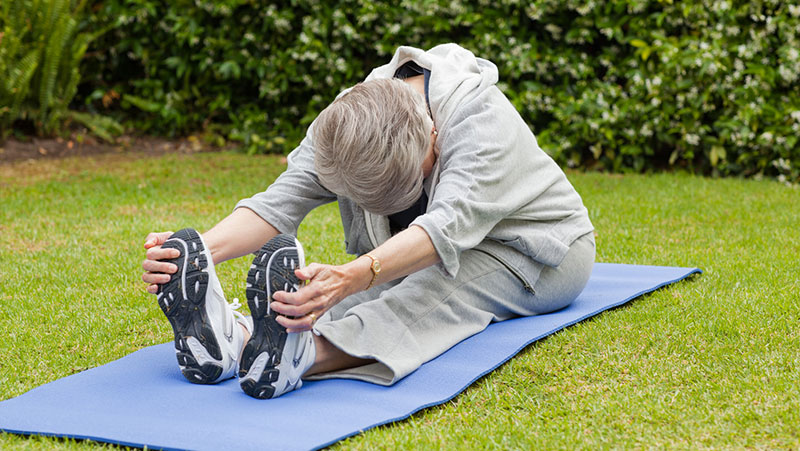8 bad workout habits to stop doing NOW

Your motivation is draining. Obstacles are blocking your path to better health. You thought you were doing everything right.
But could it be that one or more of these bad workout habits are sabotaging your efforts in the gym?
Stop committing these fitness faux pas. Whether they’re mental or behavioral, recognizing your bad habits is the first step to putting an end to them.
#1: Stretching before exercise
Stop trying to touch your toes before you hit the treadmill!
Researchers have found that stretching before a workout doesn’t actually improve range of motion or decrease your risk of injury.
Not only that, but stretching before exercise can do more harm than good. A 2010 study published in the Clinical Journal of Sport Medicine found that people who attempted passive stretches were less flexible than those who performed active warm-ups. It could be that pre-workout stretching impairs strength, hampering your fitness efforts.
Try this: A light, active warm-up before your workout and cool-down stretches post-workout.
#2: Choosing exercise over sleep
Don’t make room for exercise by cutting down on sleep.
Sleep is essential to health in numerous ways. Not enough sleep can affect judgment and mood, and chronic sleep deprivation increases the likelihood of premature death and the risk of serious disease and heart attack.
Plus, a lack of sleep leads to hormonal disturbances in appetite — studies show that the less sleep you get, the more likely you are to be overweight!
Try this: Most adults need seven to eight hours for optimal health. Without forgoing your slumber, see where else in your day you can squeeze in a workout.
#3: Letting arthritis, an injury, or another physical ailment keep you from exercise
Suffering from arthritis? There’s no need to be confined to a chair and sidelined from physical activity.
Exercise actually helps ease joint pain and stiffness. That’s because inactivity weakens muscles, notably the ones surrounding your joints, causing them greater stress. Not only can moderate exercise improve arthritis symptoms, it increases bone health and can aid in weight maintenance.
Likewise for people recovering from minor surgeries or injuries — light activity speeds the healing process. Cardiovascular exercise increases the heart rate, sending nutrient-rich blood to damaged tissues to aid in repair.
Try this: If exercising on land is too much to handle, start with water exercises. Since water is buoyant, it relieves your joints of body weight. Warm water helps to soothe muscles and tender areas, and since water is naturally resistant, even the simplest movement performed in the water helps increase muscular strength.
#4: Ignoring strength training
If someone ever tells you she doesn’t lift weights because she doesn’t want to look like a bodybuilder, tell her to snap out of it.
Muscle has less volume than fat. So when you gain muscle, your measurements will shrink, whether or not the numbers on the scale budge. Plus, the more muscle mass you have, the more calories you burn while at rest.
Strength-training is especially important for older adults — new UCLA research suggests that muscle mass and longevity are linked.
“In other words, the greater your muscle mass, the lower your risk of death,” said Dr. Arun Karlamangla, co-author of the study. “Thus, rather than worrying about weight or body mass index, we should be trying to maximize and maintain muscle mass.”
Try this: Incorporate strength-training in your cardio routine. Kettlebell exercises combine the benefits of weightlifting and aerobic exercise, according to the American Council on Exercise.
#5: Being too dependent on weight machines
Weight machines are good for beginners — they can assist with control of movement, proper form, and guide a specific range of motion — and there’s little risk of injury to the user. However, their main disadvantage: they’re usually not functional to everyday movements.
Take the leg extension machine: It’s a movement humans don’t perform in their daily lives. Instead, try squats to strengthen your quadriceps — this movement is one you do often, every time you sit down and stand up again!
Try this: If you’ve been using the weight machines for a while, it’s probably time to challenge yourself with free weights like dumbbells and barbells. Since they require more coordination and control, in addition to the targeted muscles, your stabilizing muscles kick in. Free weight exercises also tend to mimic real-life movements and incorporate multiple muscle groups.
[VIDEO PLAYLIST: Free Weight Exercises]
Subscribe to our newsletter
It's quick and easy. You could be one of the 13 million people who are eligible.
Already a member? Click to discover our 15,000+ participating locations.
Follow Us
#6: Living by the mantra “no pain no gain”
Exercise shouldn’t be physically painful, and your workout shouldn’t bring you to the edge of despair. If you feel any pain, call it a day. That may be a sign you have an injury or are using poor form.
It’s common to feel sore after a workout, But if you don’t, that doesn’t mean your workout wasn’t effective or worthwhile. Keep it up! When you’re ready, consider taking it up a notch.
Try this: Aim for moderate-intensity exercise — a 30-minute brisk uphill walk will do.
#7: Ignoring your diet
An effective weight loss strategy shouldn’t focus solely on exercise. No matter how much or how long you exercise, weight loss (or gain) is largely affected by what you eat.
“Diet is just as important as fitness,” explains Mac Gambill, a former trainer and a co-founder of the health app Nudge. “Consuming an unhealthy diet counteracts all the effort and dedication of going to the gym.”
To lose one pound of fat, you need to burn approximately 3,500 calories, according to the Mayo Clinic. For most people, it’s much easier to eliminate 500 calories a day from their diet than to burn 500 calories (and usually, more time-efficient. If you want to run up a 500-calorie deficit, it takes one hour to burn 500 calories at the gym. It takes milliseconds to decide to forego eating five donut holes).
Try this: The most successful route combines good nutrition with regular exercise. Plus, if you make exercise a normal part of your week, you can worry less about the occasional high-calorie indulgence.
#8: Thinking it’s too late for you
If you think you’re “too old” or “too out-of-shape” for any physical activity to make a difference, you’re wrong. Even though it may seem daunting to suddenly begin an exercise regimen, even a little bit of exercise can greatly increase your quality of life.
Studies have shown that no matter what age you start, sedentary participants who took up consistent exercise were much more likely to stay healthy than inactive participants.
It’s never too late — but then again, it’s never too early. So don’t put off your healthy lifestyle another minute!
Before you start fearing you won’t fit in, consider this: The average age of a gym-goer is 40. Fitness centers might seem like the domain of the young, but that’s only because the young draw a lot of attention.
The truth is most fitness centers are not filled with bodybuilders and fitness models — just average people like you looking to improve their health.




